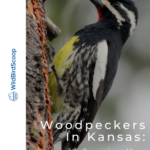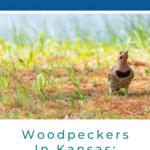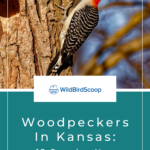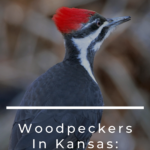Kansas is mainly famous for its fantastic vistas of vast flatlands that house one of the largest areas of prairie in the world. And let’s not forget the extensive fields of blooming sunflowers, which is why Kansas is known as “The Sunflower State”.
But if you head off to the north, you’ll be even more dazzled by the mesmerizing 5.2 million acres of forests and woodlands — that’s where you’ll get to gaze upon the colorful native birds of this state.
As much as we hate it, we can’t cover all of these birds in one article. Today, we’ll speak about all woodpeckers in Kansas, how to identify them, and how to attract them. Let’s get going!
Downy Woodpecker

- Scientific Name: Dryobates pubescens
- Length: 5.5–7 inches
- Weight: 0.7–1.2 ounces
- Wingspan: 10–12 inches
It’s pretty impossible to visit Kansas without spotting dozens of downy woodpeckers. They usually head off to locals’ backyards to enjoy tiny treats of suet, black oil sunflower seeds, millet, and peanut butter cubes.
With a maximum weight of 1.2 ounces, they sure are the smallest woodpeckers in North America. If you’re not experienced enough to evaluate the size, you can still identify them by the red napes, short bills, striped heads, and spotted wings.
Hairy Woodpecker

- Scientific Name: Dryobates villosus
- Length: 7–10 inches
- Weight: 1.5–3.5 ounces
- Wingspan: 13–17 inches
With red napes, spotted wings, and striped heads, the Hairy woodpeckers look strikingly similar to the downy species. The only feature that sets them apart is the bill’s length. The hairy species have longer, stronger bills, which allow them to dig deeper and larger nests.
Because the hairy woodpeckers are year-round residents in Kansas, it’s fairly easy to spot them. Filling your backyard with suet and black oil sunflower seeds will improve your odds of seeing one, especially during winter.
Northern Flicker (aka Yellow-Shafted Flicker)

- Scientific Name: Colaptes auratus
- Length: 11–14 inches
- Weight: 3–6 ounces
- Wingspan: 17–21 inches
With brown heads, barred wings, and spotted bellies, you can’t confuse the northern flickers with any other woodpeckers. They’re also famous for having black spots extending from their beaks, in addition to bright yellow patches on the tail.
Lucky for you, these woodpeckers are year-round citizens in Kansas. Search amid the prairies and lands with short grass; the northern flickers like to peck these areas, searching for ants and small worms.
Red-Headed Woodpecker

- Scientific Name: Melanerpes erythrocephalus
- Length: 7.5–10 inches
- Weight: 2–3.5 ounces
- Wingspan: 16–17 inches
As the name implies, the red-headed woodpecker is famous for its crimson head, neck, and throat. Almost all of its underparts are white, while black predominates the upperparts.
Unlike most woodpeckers, this species occasionally searches for food inside residential backyards, especially during the summer. That’s why you’ll find hundreds of suet feeders installed everywhere around Kansas. We absolutely appreciate these kinds of initiatives, especially that those woodpeckers are currently experiencing a major population decline.
Despite looking fairly cute, these woodpeckers fiercely defend their territories against other birds. They may even enter ducks’ nests to puncture their eggs! That’s why the early Cherokee Indians used them as a symbol of war.
Red-Bellied Woodpecker
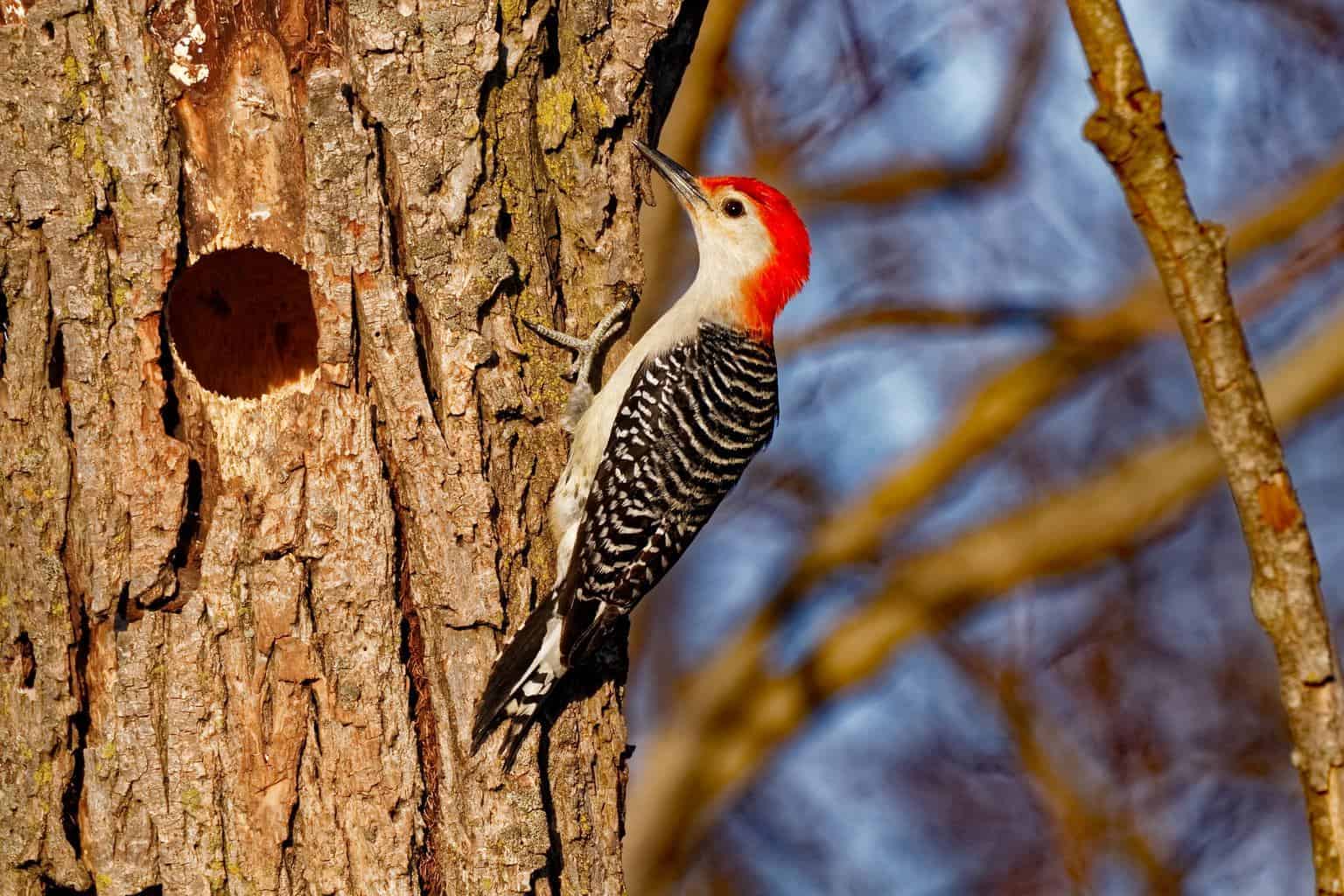
- Scientific Name: Melanerpes carolinus
- Length: 9–10.5 inches
- Weight: 2–3 ounces
- Wingspan: 15–18 inches
Despite their name, red-bellied woodpeckers have rather pale, plain bellies. They should’ve been called red-naped woodpeckers, owing to the prominent red cap spanning from their bills to the napes. But as you’ll see later on, the latter name was already registered by another species. If you want an easier way to identify them, look for the black-and-white barred back, wings, and tails.
Just like their red-headed cousins, these woodpeckers don’t hesitate to visit local feeders to enjoy tasty suet throughout the year. They also savor peanuts and black oil sunflower seeds.
If you think woodpeckers are noisy, wait till you hear those! In addition to hollow trees, they like to drum on aluminum roofs and metal gutterings. But no matter what they do, you can’t get mad at those cute creatures!
Williamson’s Sapsucker
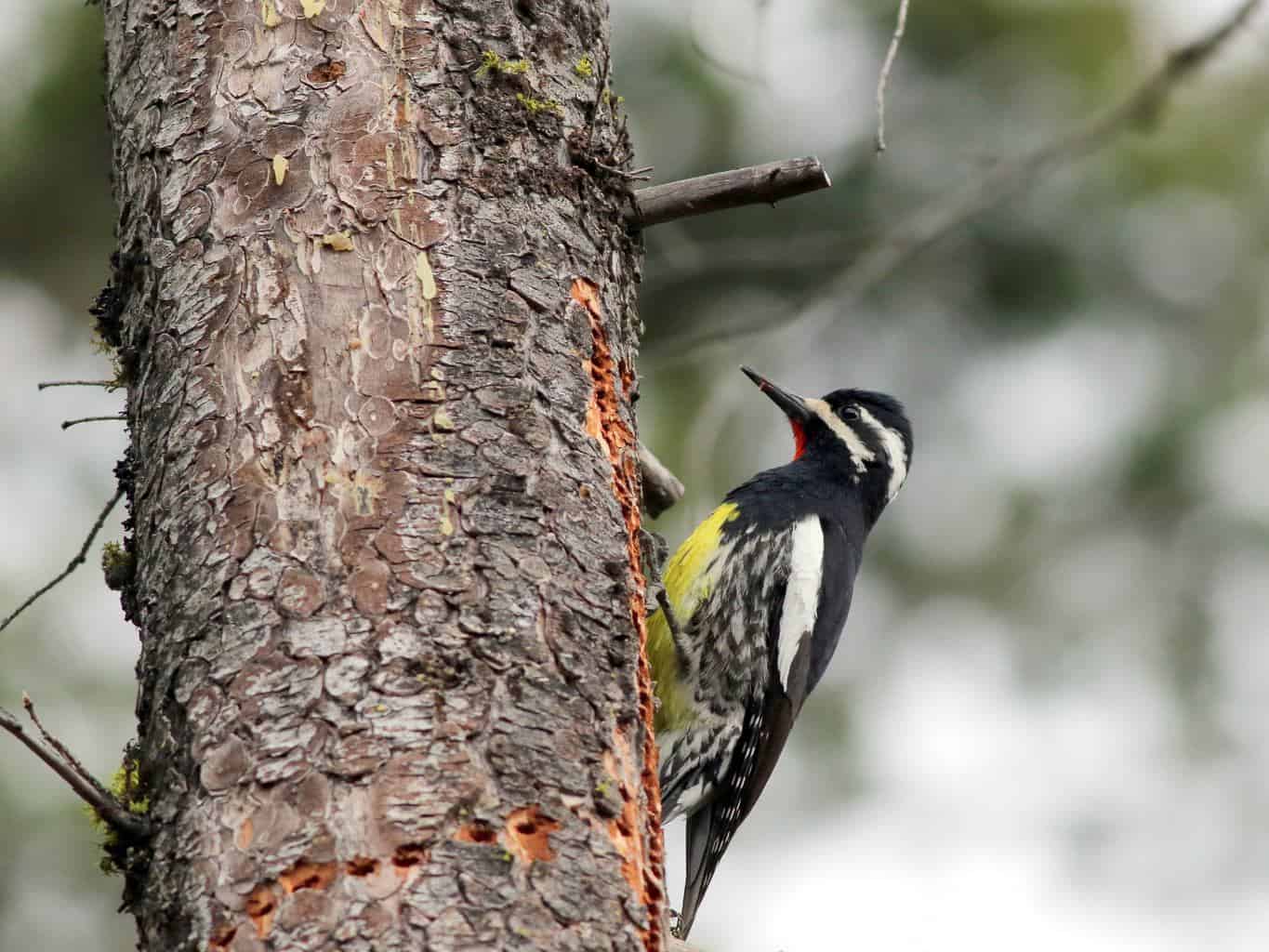
- Scientific Name: Sphyrapicus thyroideus
- Length: 8–10 inches
- Weight: 1.5–2 ounces
- Wingspan: 16–17 inches
Most woodpeckers have relatively subtle differences between males and females. That’s not the case here, though. The two sexes of Williamson’s sapsuckers look so different that they were previously classified as two different species. The male is mostly black with white patches on the wings and head. The female has black-and-white barred bodies with a brown head.
Both sexes often feed inside coniferous forests. However, you’re more likely to find their nests dispersed on mature aspens, especially those softened by heart-rot fungi.
Yellow-Bellied Sapsucker

- Scientific Name: Sphyrapicus varius
- Length: 7.5–8.5 inches
- Weight: 1.5–2 ounces
- Wingspan: 13.5–16 inches
While visiting one of the beautiful parks of Kansas, you may hear soft meows coming from tall perches. If this happens, don’t hurry to report a stranded kitten; this will likely be a yellow-bellied sapsucker.
Unfortunately, the look of this woodpecker isn’t as unique as its calls. It often has a jarred back with black wings that show a clear, vertical white stripe. The male will have a red crown and throat, while the female will have a red crown and white throat.
If you want to spot these woodpeckers, you’d better search during the winter before they migrate in April.
Red-Naped Sapsucker

- Scientific Name: Sphyrapicus nuchalis
- Length: 7.5–8.5 inches
- Weight: 1–2.5 ounces
- Wingspan: 16–17 inches
At first glance, you may not be able to tell the red-naped and yellow-bellied sapsuckers apart. They both have red crowns, red throats, black upperparts, and whitish bellies. However, if you look real close, you’ll find small red patches over the napes of the red-naped sapsuckers, hence the name. Plus, males and females are visually identical, unlike the yellow-bellied species.
It’s a bit hard to spot these woodpeckers in Kansas. You should mainly search in the far western lands, especially amid aspens, birches, and willows.
American Three-Toed Woodpecker

- Scientific Name: Picoides dorsalis
- Length: 7.5–8.5 inches
- Weight: 2–2.5 ounces
- Wingspan: 14–15 inches
In addition to the missing rear toe, the American three-toed woodpecker is famous for its black-and-white barred flank. The head and wings are often black, while the back might be black or white.
While females have black crowns, males are easily identified by their yellow crowns, which make them look a bit like macaroni penguins.
Because these woodpeckers are native to Canada and Alaska, you’ll only spot them in Kansas during the winter.
Ladder-Backed Woodpecker

- Scientific Name: Dryobates scalaris
- Length: 6.5–7.5 inches
- Weight: 0.7–1.7 ounces
- Wingspan: 13–14 inches
With a fascinating mix of barred back and checkered wings, the ladder-backed woodpeckers top the list of our favorite species. You can easily tell males and females apart by the reddish crowns that adorn the former’s heads.
Because these woodpeckers prefer dry environments, they’re more common in southwestern states. They often nest inside desert shrubs, thorn forests, and dead cacti — which is why some people call them “cactus woodpeckers”.
That said, you can spot them in western Kansas during the summertime.
Pileated Woodpecker

- Scientific Name: Dryocopus pileatus
- Length: 16–19 inches
- Weight: 9–14 ounces
- Wingspan: 26–30 inches
Do you remember the iconic Woody Woodpecker? Many people believe that it was based on pileated species because of the striking similarities. You can easily spot them by their prominent red crest that looks like spiky mohawks.
Based on the stats above, it’s clear that pileated woodpeckers are the largest species in the US. Their powerful bills can dig characteristic rectangular chambers, especially in dead trees that contain abundant insect life.
These woodpeckers are often spotted around the Arkansas River, but you can generally find them in most western lands.
Lewis’s Woodpecker

- Scientific Name: Melanerpes lewis
- Length: 10–11 inches
- Weight: 3–5 ounces
- Wingspan: 19–20.5 inches
We couldn’t find a species to finish our list better than Lewis’s woodpecker. With dark green upperparts, grey collars, and pink belly, this is one of the most beautiful birds you’ll ever see.
But much to our disappointment, Lewis’s woodpeckers are transient species, meaning that you’ll rarely see them in Kansas. If you want to improve your odds, head off to the large, open areas that have scattered trees. The Lewis’s like these habitats because they often forage on insects by swooping down from perches, much like flycatchers.
To Sum Up
Among all the woodpeckers in Kansas, the downy and hairy species are the most predominant. The fact that they’re brave enough to explore residential backyards secure a nearly permanent food source for them. North flickers are also common, but not around backyards.
During summer, you’ll likely spot the red-headed and ladder-backed woodpeckers. On the other hand, winter will reveal yellow-bellied sapsuckers and the American three-toed woodpeckers.
If you’re visiting Kansas soon, consider dropping by Colorado. You can find almost all of the previously mentioned species there. Check out our separate article for the 13 most common woodpeckers in Colorado.






